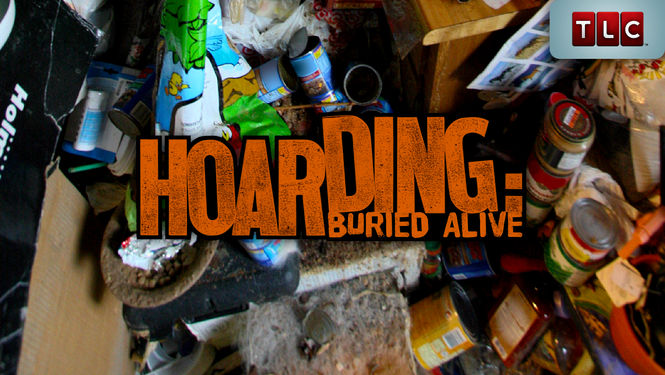Written by Jessica Rasmussen, Ph.D.
Click here for PDF
The episode of Hoarding: Buried Alive, ‘Welcome to My Nightmare,” by TLC portrays two individuals, Chris and Laurie, both of whom are struggling with hoarding. As the episode begins, we are introduced to the profound effect that hoarding has had on their lives. For Chris, a 46 year-old Navy veteran, hoarding has left him unable to have others enter his home. Even those closest to him, such as his girlfriend, Annie, are not welcome. For Laurie, a 48 year-old married homemaker with three grown children, even routine family activities, such as gathering around the dining room table for dinner and having her grandchildren over to the house, are impossible. Chris and Laurie’s ability to use living spaces in their home, such as the kitchen and commons areas, is compromised. The portrayal of Chris and Laurie’s day-to-day struggle with hoarding is an accurate representation of what many individuals with hoarding problems experience. Hoarding is characterized by a difficulty with or an inability to discard ordinary items that results in an excessive accumulation of possessions in one’s living space. Often times, as is the case with both Chris and Laurie, the difficulty discarding items is accompanied by a tendency to acquire more items than one needs or can be used. Hoarding can lead to difficulties in the use of living spaces and daily functioning, but it can also have a major impact on other areas of one’s life, such as relationships with family and friends.
 Chris’s hoarding has prevented him from having friends and family over to his home and his girlfriend, Annie, has yet to step foot in Chris’s townhouse. During the episode, Annie visits Chris’s townhouse for the first time in their relationship and voices shock over the condition of the home. Laurie’s hoarding has caused significant strain in her relationship with her husband and children. Although Laurie and her husband seem to get along well and Laurie describes him as her “emotional rock,” her husband says that they have often disagreed on whether Laurie should keep various possessions and he has been frustrated enough to go live with his sister for several weeks at a time. Laurie’s daughter, Annabeth, also featured in the episode, is distressed over her mother’s hoarding problem, specifically because it interferes with bringing her children over to visit their grandparents. These kinds of relationship difficulties are common among individuals with hoarding. In fact, it is often family members and friends of the individual who is hoarding who urge their loved ones into treatment.
Chris’s hoarding has prevented him from having friends and family over to his home and his girlfriend, Annie, has yet to step foot in Chris’s townhouse. During the episode, Annie visits Chris’s townhouse for the first time in their relationship and voices shock over the condition of the home. Laurie’s hoarding has caused significant strain in her relationship with her husband and children. Although Laurie and her husband seem to get along well and Laurie describes him as her “emotional rock,” her husband says that they have often disagreed on whether Laurie should keep various possessions and he has been frustrated enough to go live with his sister for several weeks at a time. Laurie’s daughter, Annabeth, also featured in the episode, is distressed over her mother’s hoarding problem, specifically because it interferes with bringing her children over to visit their grandparents. These kinds of relationship difficulties are common among individuals with hoarding. In fact, it is often family members and friends of the individual who is hoarding who urge their loved ones into treatment.During the episode, Chris and Laurie describe their relationship to possessions. Chris relates the enjoyment he receives from buying nice items, but at the same time, laments the fact that he often never gets around to using them because of the clutter. He identifies with the notion that while others may throw away an item that they don’t use within an certain time frame, he feels unable to do so, having a number of plans for how he might use the item in the future. Laurie describes her appreciation for items that she sees left out on the street or in thrift stores and often thinks of how they would look good in her home. She is also concerned about the items going to waste. These reasons for saving and acquiring possessions are frequently described by those with a hoarding problem. Another frequent reason for saving is the sentimental attachment that individuals feel towards their possessions. Individuals with hoarding typically save the same types of items that everyone does (e.g., clothing, papers), however, it is the frequency and amount of items they save that differs.
The episode also portrays Chris and Laurie seeking a form of evidence-based treatment for hoarding, known as cognitive-behavioral therapy. Chris and Laurie both begin by meeting one-on-one with cognitive-behavioral therapists in their home. The therapists work with Chris and Laurie to examine their thoughts and feelings regarding their possessions, in order for them to make decisions about whether to eventually save or discard items. This is a common technique used in cognitive-behavioral therapy for hoarding and is done, as shown in this episode, by sorting through possessions one-by-one together. Laurie’s therapist also conducts an experiment with her, in which he asks her to imagine him taking one of her possessions out of the house, without the guarantee of where it will end up. This imagined scenario provokes anxiety in Laurie, but also allows her to begin experiencing some of the negative emotions she has been avoiding by not discarding, with the support of her therapist. Cognitive-behavioral therapy for hoarding also involves gradually exposing oneself to discarding items that one may no longer need or have use for and tolerating the negative emotions that arise. Over time, the negative emotions decrease and discarding items becomes easier. Both of the individual therapists emphasize the importance of allowing the person with hoarding to make gradual gains in treatment and to avoid the method of a mass clean out, as this usually never works long-term. Chris and Laurie also meet one-on-one with a professional organizer who works with and supports them in the decluttering process.
At the close of the episode, both Chris and Laurie have made meaningful gains in treatment. Laurie has completely decluttered her dining room and gathers people for sit down dinner at her dining room table. Her husband and daughter Annabeth reflect on the progress she has made in treatment and express hope for the future. Chris has steadily cleared out portions of various living spaces in his townhouse and looks forward to the possibility of having friends over in the near future to spend time on his deck in the backyard. He has enlisted the support of his brother Jason. .Jason is impressed with the gains he has made thus far. Both Chris and Laurie recognize the need for continued work on the hoarding but are hopeful about their ability to continue making improvements down the road.
©2012 Massachusetts General Hospital OCD and Related Disorders Program | Reprint only with permission


